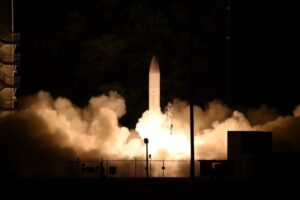A new team at the Pentagon is seeking proposals to help “address gaps in the technology and manufacturing supply chain” for hypersonic weapons, with the department aiming to find solutions that could help cut the estimated production cost of the future capabilities by 30 to 80 percent.
A DoD notice published on July 28 details the new Innovation Capability and Modernization (ICAM) team’s interest in technologies and strategies that could advance production capacity for a range of critical hypersonic weapon components, to include thermal protection systems, additive manufacturing for scramjet engines, cables and wiring, glide body subsystems and integration and forgings and castings.

“The focus of the ICAM team is to improve hypersonics supply chain technologies, to reduce costs, increase manufacturing capacity and bring disruptive technologies to address critical gaps impeding production advancements,” states the notice published on July 28. “All investments will be selected with the goal to transition, and the ICAM office will work closely with the services and agencies – identified as recipients of these advancements – to ensure requisite steps are taken throughout the process to enable transition.”
The Pentagon is pursuing development of major hypersonic weapons across the services, to include the Air Force’s Hypersonic Attack Cruise Missile (HACM), the Army’s Long Range Hypersonic Weapon (LRHW) and Navy’s Conventional Prompt Strike (CPS) programs.
Heidi Shyu, the under secretary of defense for research and engineering, has said previously she wants to make hypersonic weapon systems more affordable, adding it’s likely to be achieved once there’s a more established industrial base in place as developmental programs move into regular production (Defense Daily, Jan. 14 2022).
The new notice states ICAM will accept proposals from industry vendors, national laboratories and academia “that accelerate the manufacturing technologies, weapons systems and integration functions,” with a specific focus on ideas and capabilities to support production of all-up-rounds for hypersonic programs.
“While ICAM is interested in all proposals that can help field systems faster, ICAM is especially interested in those that reduce cost and reduce production time of All-Up-Round components, and in many cases the efforts will seek an order of magnitude cost reduction,” officials write in the notice. “The desired result will be to develop proposals that affect key gaps in the development timeline and show significant promise to advance the hypersonics enterprise in terms of capacity increases and cost reductions.”
The ICAM team said the aim is to support proposals that detail the “equipment, processes and personnel necessary to achieve cost reductions and higher rates of production capacity” for hypersonic weapons.
A National Defense Industrial Association (NDIA) report released in May found the Pentagon has been “ambiguous” in its commitment to hypersonic systems, adding the department needs to be more consistent in its plans and outlook for developing and acquiring hypersonic weapons to ensure it has a ready industrial base to build these systems (Defense Daily, May 11).
Prime contractors working to support hypersonics programs such as HACM, LHRW and CPS include Lockheed Martin [LMT], RTX [RTX], Northrop Grumman [NOC] Dynetics [LDOS] and General Atomics.Northrop Grumman on Thursday detailed its new Hypersonics Capability Center (HCC) in Elkton, Maryland, which it said will be focused on integrating research, development, testing and production of hypersonic air-breathing propulsion systems to meet planned and future demand at scale (Defense Daily, Aug. 3).